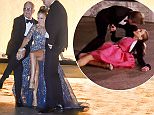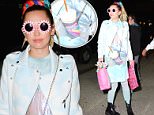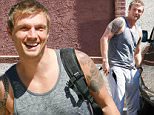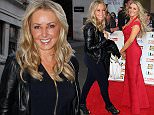The leukaemia girl and the baby brother who couldn't be her saviour
Like most mothers, Sarah Strudwick wept at the birth of her son. But her tears were of happiness and sorrow.
She and her husband Kelvin had longed for the baby, having undergone months of IVF treatment to conceive. His arrival - healthy and weighing 6lb 9oz - was a relief.
But the Strudwicks had hoped their son Ezekial would be a 'saviour sibling': that stem cells harvested from his umbilical cord and placenta would provide the key to curing his three-year-old sister Ysabella, who is in remission from leukaemia.

Staying positive: Sarah and Kelvin Strudwick with Ezekial and Ysabella, who is in remission from leukaemia
Although chemotherapy has rid her body of cancer, there is a chance she could relapse.
But a month before their son was due, the couple discovered there wouldn't be enough stem cells from one baby to save their daughter should she become ill again - Ysabella had grown so much the cord of two babies would be needed.
The couple knew, after the expense and physical ordeal of IVF, they would never have another baby.
'As Ysabella's consultant had told us there wouldn't be enough stem cells, the NHS wouldn't pay for them to be collected at the birth,' explains Sarah.
'Even if we did want another child, having the stem cells collected and stored privately costs £2,000, which we just couldn't afford.'
And so when Ezekial was born on January 6 this year, Sarah, 33, was left with no choice but to let the placenta and umbilical cord - and her hopes - be disposed of as clinical waste.
'I thought Ezekial would bring us peace of mind for Ysabella,' she says. 'And though he is a gorgeous baby and we wouldn't be without him for the world, he hasn't been able to do what we thought he could.'
Sarah and Kelvin, 34, a clinical scientist, are the first to admit that until Ysabella's illness, they had given only a passing thought to extending their family.
The couple, who live in Oldham, were already parents to Ethan, 13, Zackery, 12, and Adrienna, 11, when Ysabella arrived on May 11, 2005.
When she was five months old, Ysabella became unwell. Tests revealed she had an enlarged liver and spleen and a blood infection. She was transferred to Pendlebury Children's Hospital in Manchester for a blood transfusion and a bone-marrow test.
The results revealed she had acute myeloid leukaemia (AML), an aggressive cancer of the white blood cells, which causes an accumulation of abnormal cells in the bone marrow, disrupting normal blood-cell production. This causes shortness of breath, bruising, bleeding and increased risk of infection, and it can be fatal.
'We were in complete shock,' says Kelvin. 'We knew Ysabella was ill but had no idea it could be so serious. Suddenly we were being told she had cancer. We kept saying, "How can this be happening?" It was too terrible for us to take in.'
According to Dr Adrienne Morgan, scientist with charity Children with Leukaemia, AML affects about a fifth of the 400 to 500 children who develop leukaemia each year.
She says: 'The condition is highly aggressive and a child will die if treatment isn't intensive.'
Over a six-month period, Ysabella had four sessions of daily chemotherapy - ranging from eight to 14 days - with a two-week break in between.

Treatment: Ysabella was just five months old when diagnosed with an aggressive form of leukaemia
'Ysabella took it so well - smiling and playing in her cot. She did all her "firsts" in hospital - sitting up, crawling and trying to stand,' says Sarah.
By March 2006, Ysabella's bone marrow was clear of leukaemia, although in AML patients there is a 25 per cent chance of it returning.
'We were overjoyed. However, this disease is so aggressive it can kill within a month,' says Sarah. 'I just felt she was so vulnerable.'
Before discharging Ysabella, doctors explained that the only treatment offering the chance of a cure, should she relapse, was stem-cell transplantation.
Stem cells are often referred to as the body's building blocks because of their ability to constantly remake new cells of every kind. Small numbers can be found in adult blood samples but they are most abundant in babies, who are still growing.
Taking blood directly from a baby is too dangerous as so much is needed - however, stem cells are abundant in the umbilical cord.
In a stem-cell transplant to treat leukaemia, chemotherapy is used to destroy the patient's bone marrow and cancerous cells. It is replaced with stem cells from a donor's blood, which divide rapidly and repopulate the bone marrow with healthy blood cells.
Through their own research, the couple discovered that donor banks do exist but there is a greater chance of success if the donor is a sibling.
The more highly matched the tissue, the lower the chance of rejection. A match with a sibling is highly likely but there is only a one in 3,000 chance of a match with a stranger.
Taking matters into their own hands, Kelvin and Sarah began trying for a baby shortly after Ysabella returned from hospital. When nothing happened, they turned to IVF.
After two attempts, they conceived in March 2008. Ysabella's doctor said a baby's cord blood would be a great help if future treatment were needed. Arrangements would be made, on the NHS, for the cells to be collected at the birth. However, in December, Ysabella's doctors told the couple that the stem cells harvested from one cord wouldn't be enough.
Sarah says: 'Because it had taken us so long to conceive, Ysabella had grown and would need cord blood from two babies for a stem-cell transplant. We had not thought of this. It was a crushing blow.'
Ysabella loves to sing and dance around her 'baby Zeke'. But their mother remains haunted by the spectre of cancer.
'We love Ezekial to bits,' she says. 'But I so hoped cord blood would give me peace of mind.
'We are so thankful for our healthy baby boy and for Ysabella's good health. We just have to pray that things stay this way.'
-
 Flipping incredible! Moment dolphin retreives mobile phone
Flipping incredible! Moment dolphin retreives mobile phone
-
 New Carl's Jr Tex Mex commercial pokes fun at border wall
New Carl's Jr Tex Mex commercial pokes fun at border wall
-
 Labeled a fake: Christian preacher 'proves' he can walk on...
Labeled a fake: Christian preacher 'proves' he can walk on...
-
 Witness captures moment Russian jets bomb Syria for first...
Witness captures moment Russian jets bomb Syria for first...
-
 Hillary staffer registers voters with pitch against Trump
Hillary staffer registers voters with pitch against Trump
-
 Sam Kellet is seen spear fishing before fatal shark attack
Sam Kellet is seen spear fishing before fatal shark attack
-
 SNL's Kenan Thompson recalls strange advice from Bill Cosby
SNL's Kenan Thompson recalls strange advice from Bill Cosby
-
 Footage on the ground after rockets hit three areas of Syria
Footage on the ground after rockets hit three areas of Syria
-
 Spiderman makes an entrance at the Yotta's 'party house'
Spiderman makes an entrance at the Yotta's 'party house'
-
 Very smart baby uses pillows to get down from bed
Very smart baby uses pillows to get down from bed
-
 First woman in 70 years executed in Georgia despite appeals
First woman in 70 years executed in Georgia despite appeals
-
 Sweet moment woman reunites with nurse who saved her as baby
Sweet moment woman reunites with nurse who saved her as baby
-
 The ultimate bad hair day: Woman ends up in hospital after...
The ultimate bad hair day: Woman ends up in hospital after...
-
 Putin signs decree drafting 150,000 conscripts into the...
Putin signs decree drafting 150,000 conscripts into the...
-
 Undercover video: Clinton campaign worker caught breaking...
Undercover video: Clinton campaign worker caught breaking...
-
 EXCLUSIVE: Jim Carrey’s tragic ex was a Scientologist and...
EXCLUSIVE: Jim Carrey’s tragic ex was a Scientologist and...
-
 John Gotti's grandson marries in 'ceremony worthy of The...
John Gotti's grandson marries in 'ceremony worthy of The...
-
 The amazing moment a dolphin gives a Miami Heat dancer her...
The amazing moment a dolphin gives a Miami Heat dancer her...
-
 Hurricane Joaquin upgraded to an 'extremely dangerous'...
Hurricane Joaquin upgraded to an 'extremely dangerous'...
-
 Body of 18-year-old missing for SEVEN years found in the...
Body of 18-year-old missing for SEVEN years found in the...
-
 Russia 'is pouring gasoline on the fire' of Syria's civil...
Russia 'is pouring gasoline on the fire' of Syria's civil...
-
 Suicides, sects, murder and insanity: The disturbing truth...
Suicides, sects, murder and insanity: The disturbing truth...
-
 Kenan Thompson shares the odd sex advice Bill Cosby gave him...
Kenan Thompson shares the odd sex advice Bill Cosby gave him...
-
 Women in Warren Jeffs' mormon cult are forced to get...
Women in Warren Jeffs' mormon cult are forced to get...

























































































































































































































































































































